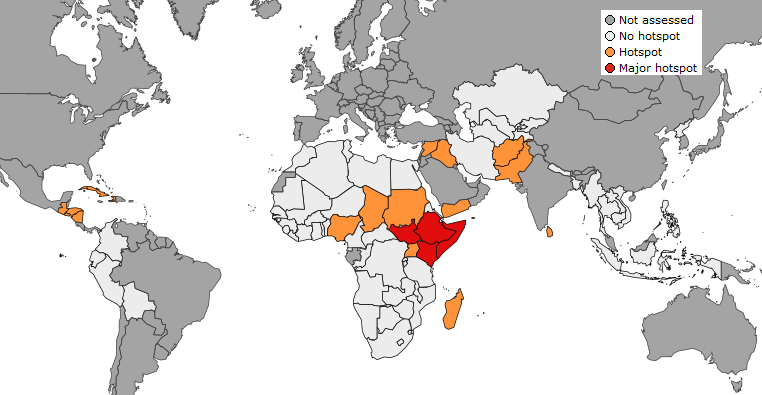
Main findings of the October global overview
- In Southern Africa, land preparation and the planting of summer crops are ongoing, and the Copernicus C3S Multimodel seasonal rainfall forecast for the November 2022 to January 2023 period is favourable overall, except for south-western Angola, north-western Namibia, northern Zambia, northern Mozambique and northern Malawi. The harvesting of winter wheat is nearing completion and production prospects are very favourable for South Africa and Zimbabwe.
- In East Africa, crop harvesting has commenced in the northern parts of the region, and although agroclimatic conditions have been generally favourable, crop production in marginal areas and livestock conditions in most pastoral areas have been seriously affected by the prolonged drought that has hit the Horn of Africa for four consecutive seasons. In addition, there are concerns for the recently started short crop season in bimodal areas in the southern part of the region, due to a combination of below-average rainfall and negative seasonal forecasts. According to IPC updates in October 2002 for the IGAD region, over 47 million are experiencing high levels of acute food insecurity (IPC Phase 3 or above).
- In North Africa and the Middle East, the sowing of winter cereals has started under warmer-than-average conditions. The harvesting of irrigated summer crops was completed with below-average prospects in Syria and Iraq, and close-to-average rice production prospects in Iran. In Yemen, although the harvesting of wheat and sorghum was completed with favourable prospects, food insecurity continues to affect 2 out of 3 people.
- In West and Central Africa, the main season is coming to an end. Despite flooding that resulted in crop losses, and conflict that impeded agricultural activities, the preliminary forecast for cereal production is around 74.3 million tonnes, close to the 5-year average and 3% above the 2021 output (FAO). Pockets of food insecurity are located in conflict-affected areas of the region.
- In Central Asia, the sowing of winter cereals is underway under warmer-than-average conditions and drier-than-average conditions are forecast for November 2022 to January 2023 for the whole region. In Afghanistan, the harvesting of irrigated rice and sowing of winter cereals have taken place under favourable conditions; however, food insecurity remains very high with half of the population (20 million people) in acute food insecurity. In South Asia, the harvesting of Kharif crops in Pakistan and rain-fed Aman rice in Bangladesh has started/is about to start with favourable prospects. However, both countries have been affected by flooding, especially Pakistan, where fields are still flooded after 3 months. In Sri Lanka, the planting of main (Maha) season rice and maize is underway under favourable weather conditions and the promise of sufficient fertiliser by the government.
- In continental South-East Asia and the Philippines, prospects for wet season rice and prospects for dry season rice in Indonesia are favourable thanks to good rainfall conditions. Similarly, in North Korea, the rice and maize harvest was completed in October and September, respectively, with good prospects.
- In Central America, harvesting for the 2022 Primera season is ongoing and the current forecast for cereal production for the region is anticipated at a near-average level. Postrera crops are in the growth phase and rainfall accumulation during October has been below average. Additionally, hurricanes Julia, Lisa and Fiona affected the region in September and October. In the Caribbean, the harvesting of main season crops in Cuba and second season crops in Haiti is ongoing; however, dryness persisted in both countries in October, aggravating the humanitarian crises, particularly in Haiti. From September 2022 to February 2023 a significant increase in the severity of Haiti's food crisis is estimated, with 4.7 million people experiencing acute food insecurity, including 19,000 classified in Catastrophe (IPC Phase 5) (IPC Haiti TWG, October 2022).
The next assessment is scheduled for the end of November 2022.
Details
- Publication date
- 10 November 2022
- Author
- Joint Research Centre
